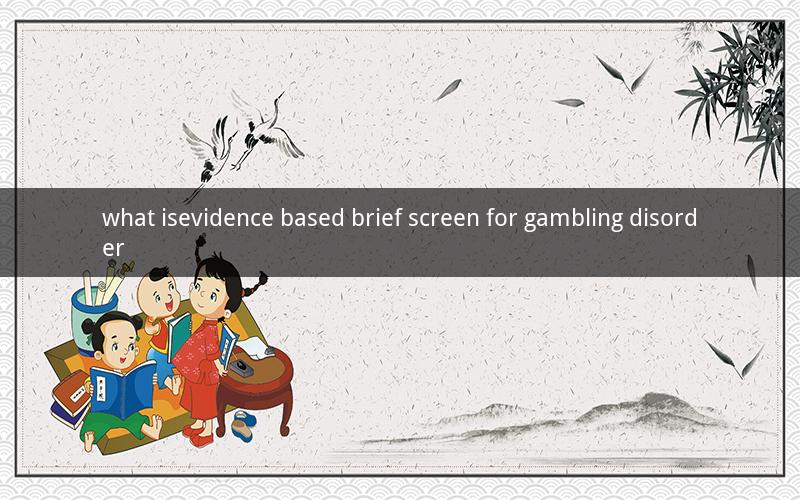
Table of Contents
1. Introduction to Gambling Disorder
2. Understanding Evidence-Based Practice
3. The Importance of Screening
4. What is an Evidence-Based Brief Screen?
5. Components of an Evidence-Based Brief Screen for Gambling Disorder
6. Development and Validation of Evidence-Based Brief Screens
7. Implementing Evidence-Based Brief Screens in Clinical Settings
8. Challenges and Solutions in Using Evidence-Based Brief Screens
9. Case Studies: Successful Implementation of Evidence-Based Brief Screens
10. Conclusion
1. Introduction to Gambling Disorder
Gambling disorder, also known as compulsive gambling, is a behavioral addiction characterized by an inability to control the urge to gamble. It can lead to significant financial, social, and psychological consequences. Recognizing the signs and symptoms of gambling disorder is crucial for early intervention and treatment.
2. Understanding Evidence-Based Practice
Evidence-based practice (EBP) is an approach that integrates the best available research evidence with clinical expertise and patient preferences. It ensures that healthcare professionals provide the highest quality of care, based on what research has shown to be effective.
3. The Importance of Screening
Screening for gambling disorder is essential for early detection and intervention. It helps healthcare providers identify individuals who may be at risk or have a gambling disorder, allowing for timely intervention and support.
4. What is an Evidence-Based Brief Screen?
An evidence-based brief screen is a concise and standardized tool designed to quickly identify individuals who may have a gambling disorder. These screens are based on research findings and are validated for their accuracy and reliability.
5. Components of an Evidence-Based Brief Screen for Gambling Disorder
An effective evidence-based brief screen for gambling disorder typically includes the following components:
- Assessment Questions: Questions that assess the presence of gambling-related behaviors and symptoms.
- Risk Factors: Identification of risk factors associated with gambling disorder, such as family history, co-occurring mental health conditions, and personality traits.
- Scoring System: A method for quantifying the severity of gambling-related behaviors and symptoms.
- Recommendations for Further Evaluation: Guidelines for determining whether further evaluation or treatment is necessary.
6. Development and Validation of Evidence-Based Brief Screens
The development and validation of evidence-based brief screens involve several steps, including:
- Literature Review: Identifying existing screening tools and evaluating their effectiveness.
- Expert Consultation: Consulting with experts in the field of gambling disorder to ensure the tool's accuracy and relevance.
- Pilot Testing: Testing the tool with a small sample of individuals to identify any potential issues.
- Validation Studies: Conducting studies to assess the tool's reliability, validity, and sensitivity.
7. Implementing Evidence-Based Brief Screens in Clinical Settings
Implementing evidence-based brief screens in clinical settings requires training healthcare professionals on how to use the tool effectively. This includes understanding the screening process, interpreting results, and providing appropriate referrals.
8. Challenges and Solutions in Using Evidence-Based Brief Screens
Challenges in using evidence-based brief screens include:
- Lack of Awareness: Many healthcare professionals are not aware of the existence or importance of evidence-based brief screens.
- Time Constraints: Limited time during clinical visits can make it difficult to incorporate screening into practice.
- Stigma: Patients may be reluctant to discuss their gambling behaviors due to stigma.
Solutions to these challenges include:
- Education and Training: Providing ongoing education and training for healthcare professionals.
- Integration into Clinical Workflow: Developing strategies to integrate screening into clinical practice without adding significant time or complexity.
- Addressing Stigma: Promoting awareness and understanding of gambling disorder to reduce stigma.
9. Case Studies: Successful Implementation of Evidence-Based Brief Screens
Several case studies demonstrate the successful implementation of evidence-based brief screens in clinical settings. These studies highlight the importance of screening in early detection and intervention, leading to improved outcomes for patients.
10. Conclusion
An evidence-based brief screen for gambling disorder is a valuable tool for healthcare professionals. By integrating these screens into clinical practice, we can improve early detection and intervention, ultimately leading to better outcomes for individuals with gambling disorder.
Questions and Answers
1. What is the difference between a screening tool and a diagnostic tool for gambling disorder?
- Screening tools are designed to quickly identify individuals who may have a gambling disorder, while diagnostic tools are used to confirm the presence of the disorder.
2. How often should gambling disorder be screened?
- Screening frequency depends on the individual's risk factors and clinical history. Some experts recommend screening annually for high-risk individuals.
3. What are some common risk factors for gambling disorder?
- Common risk factors include family history, co-occurring mental health conditions, and personality traits such as impulsivity and sensation-seeking.
4. How can healthcare professionals address stigma associated with gambling disorder?
- Healthcare professionals can address stigma by promoting awareness, using non-judgmental language, and providing education about the disorder.
5. What is the role of family members in supporting individuals with gambling disorder?
- Family members can play a crucial role in supporting individuals with gambling disorder by providing emotional support, encouraging treatment, and maintaining open communication.
6. How can evidence-based brief screens be integrated into primary care settings?
- Evidence-based brief screens can be integrated into primary care settings by incorporating them into routine patient visits and providing training for healthcare professionals.
7. What is the relationship between gambling disorder and other mental health conditions?
- Gambling disorder often co-occurs with other mental health conditions, such as depression, anxiety, and substance use disorders.
8. How can individuals with gambling disorder seek help?
- Individuals with gambling disorder can seek help by contacting a healthcare provider, therapist, or support group.
9. What is the most effective treatment for gambling disorder?
- The most effective treatment for gambling disorder typically involves a combination of cognitive-behavioral therapy, medication, and support groups.
10. How can researchers continue to improve evidence-based brief screens for gambling disorder?
- Researchers can improve evidence-based brief screens by conducting ongoing validation studies, incorporating new research findings, and seeking feedback from healthcare professionals and patients.